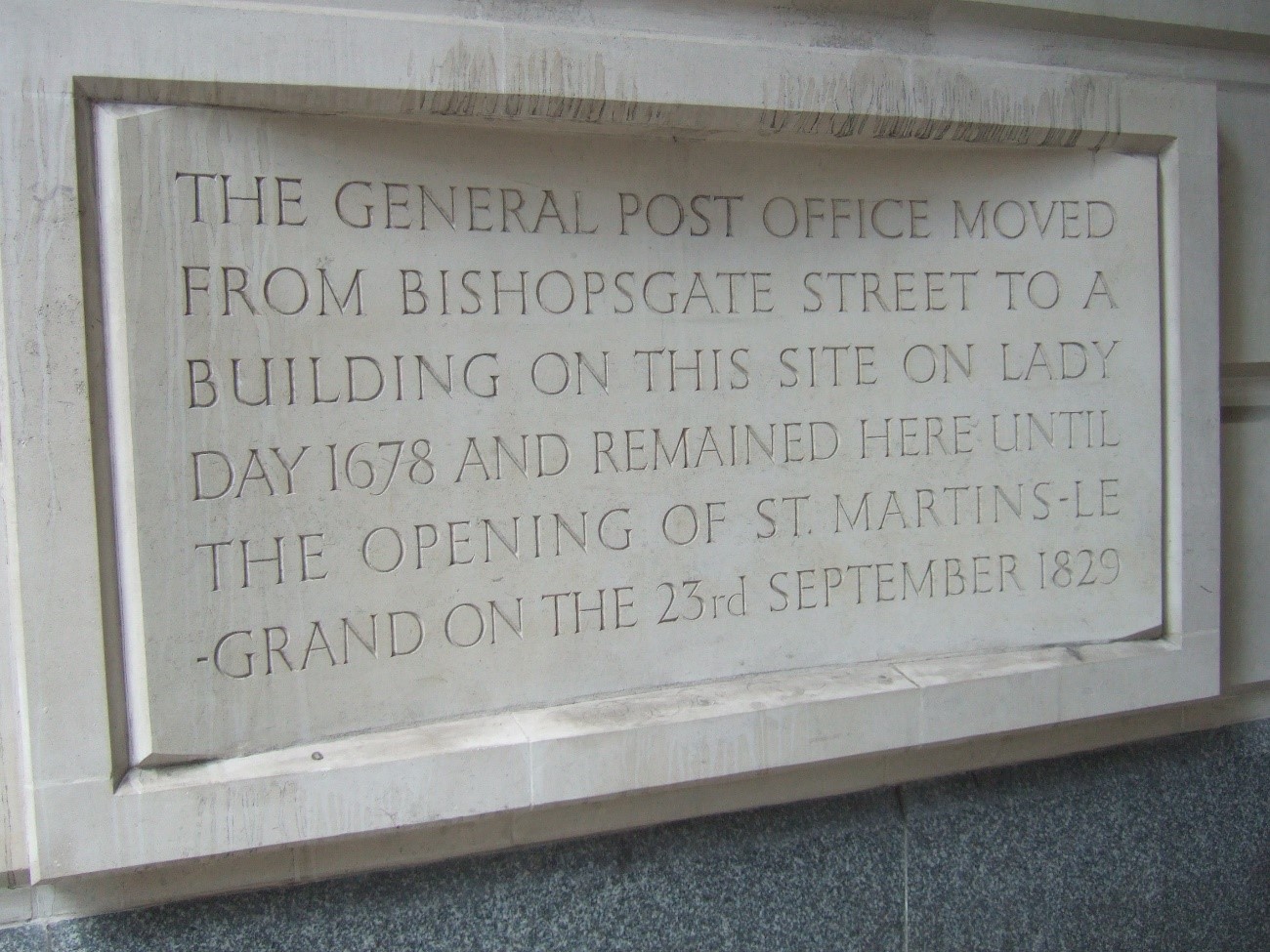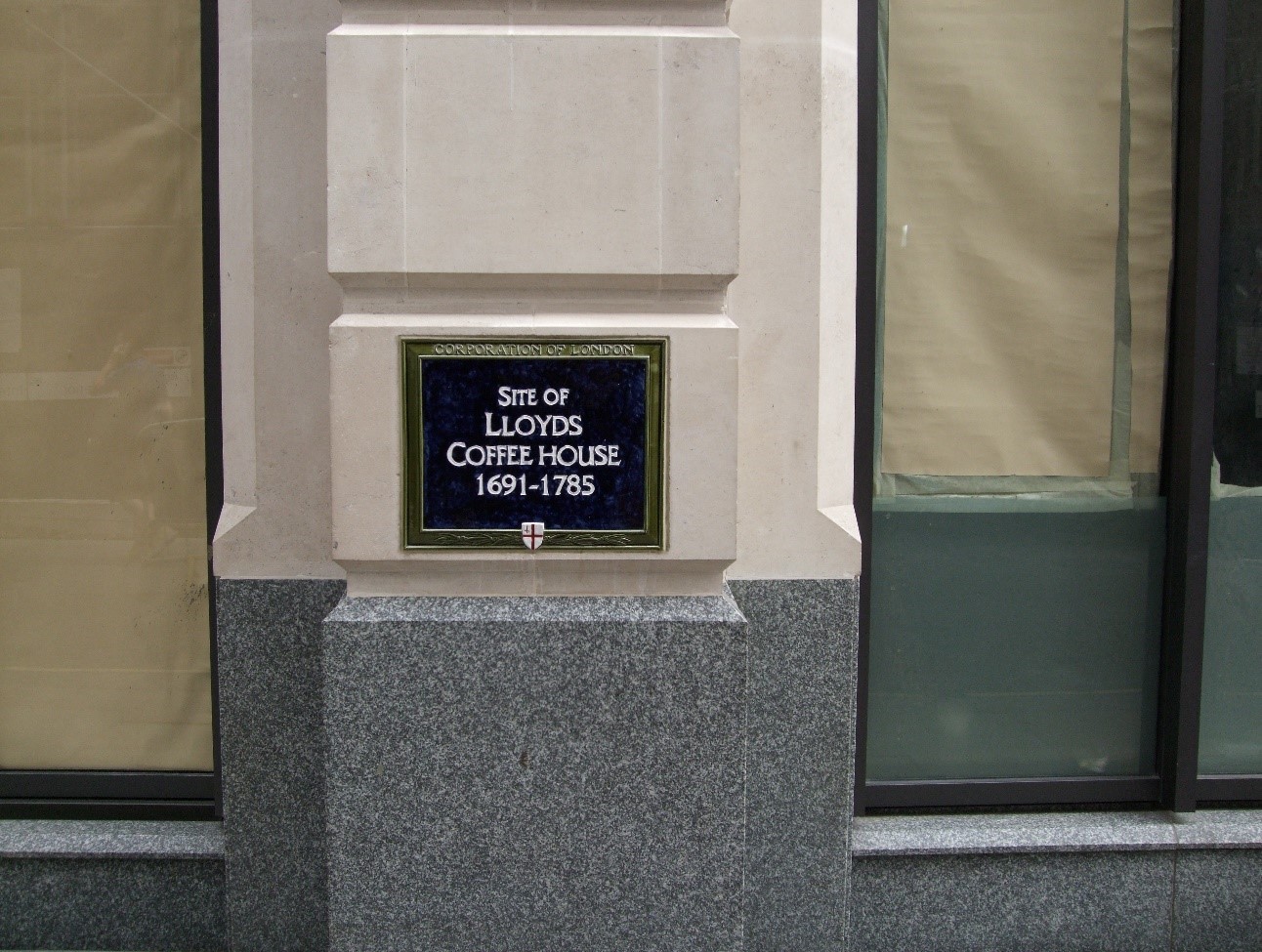企業戦略 2020.10.24
CS14 ロイズ発展の理由 Reasons for the development of Lloyd’s of London
目次
For those who prefer to read this column in English, the Japanese text is followed by a British English translation, so please scroll down to the bottom of the Japanese text.
先日、業務提携先のあるハワイへ、書類の原本をどうしても送る必要があり、郵便局に行ったところ「コロナ禍で飛行機が飛んでいないので、船便で4~5週間掛かることを覚悟しておいてください」と言われた。「当たり前だと思っている、迅速な郵便制度の有り難み」に改めて気づかされた気がした。企業戦略上、この郵便制度の重要性に早くから気がつき、その恩恵を受けた世界的な機構がある、英国の保険機構、ロイズ(Lloyd’s of London)である。
「なぜ、一保険取引業者にしか過ぎなかったロイズが、今日世界的規模の一大保険市場になり得たか」という問いが提起されたら、「企業戦略上、自らの事業に於いて通信手段が如何に重要であるかということを的確に理解して、その戦略の策定と実行をおこなったからである」と答えるであろう。

(「ロンドン中央郵便局」の銘板:1678年~1829年)
(“London Central Post Office” nameplate: 1678-1829)
1. ロイズ・コーヒーハウス
1600年代末、エドワード・ロイドが、当時の社交場、商取引の場所として人気が出始めていた「コーヒーハウス」(喫茶店)をロンドン観光の定番スポットである「タワーブリッジ」の傍ら、タワーストリートに開いた。その店は、彼の名前を冠して「エドワード・ロイドのコーヒーハウス(Edward Lloyd’s Coffee House)」と呼ばれた。Lloyd’s(Lloyd’s of London) の淵源である。
大西洋に注ぎ込むテムズ川の河口沿いにある街が、ロンドンである。このため多くの海運業者が店に集まり、海事ニュースを発行して有名になった。海運業者、荷主が集まれば、「海上運送リスクをどうするか」が当然、話題の中心、保険を引き受ける商人が自然と誕生した。
コーヒーハウスには、保険の引受の検討をするため、「船名、船歴、荷物、船長、航海のスケジュール等々」が描かれたボードが掲げられ、その下に「引き受ける人間」が引受け割合を記し、サインをした。この伝統は、今でも「保険証券の下の方にサインすること」で受け継がれているが、そのためこの保険を引き受ける人のことを「Underwriter(アンダーライター)」と呼ぶようになったといわれている。
保険のビジネスが大きくなっていくと、もともとはアンダーライターの経営する会社の使用人だった人たちが独立してアンダーライターと保険を掛けたい人たちの間を取り持つ「保険仲介業」をおこなうようになり、彼らのことを「ブローカー」(保険仲立人)と呼ぶようになって、彼らが相互に連携した「保険市場」が店のなかに生まれたのである。この保険を引き受ける富裕者が集まった集団が構成され、時を経てその組織は「シンジケート」と呼ばれるようになった。やがて、ブローカーが仲介して、他のシンジケートとともに引き受けしてリスク分散を図るようになっていったのである。

(ロンバートストリート16番地にある、第2代目ロイズ・コーヒーハウスの跡地)
(The site of the second Lloyds Coffee House at 16 Lombard Street.)
ビジネスの規模も大きくなってきたロイズ・コーヒーハウスは手狭となり、1691年、当時も、また今もビジネス街の中心地であるロンドンのシティの一角、ロンバードストリート16番地に移転した。この移転の理由は、1678年この場所のすぐ隣にロンドン中央郵便局ができ、世界中の情報が郵便という手段で集まってくる「中心地」に最も近い場所だった。郵便配達のシステムが完備された現代と違い、17世紀最も早く郵便を受け取る手段は、郵便局の中につくられた私書箱を開けることであったからである。
2.英国に於ける郵便の歴史
英国の郵便事業は、「ロイヤルメール(Royal mail)」という企業が担っている。以前は、郵政省管轄だったが、1969年に法人化され、現在は民営企業として事業経営されている。
ロイヤルメールが誕生したのは約500年前、ヘンリー8世の時代(1509〜1547年)である。彼は、主に自分の書簡を遠方に届けるため、Royal mail(王室の郵便)制度を1516年につくった。当然、この制度は王および王室のためだけのサービスであったが、このために、各町には、郵便配達用の馬を最低3頭ずつ配備して王室の手紙やお触れ等を配達させた。この馬を飼っておく小屋は当時「ポスト」と呼ばれた、ポストの語源がここで誕生したのである。
王室以外の一般人は、プライベートな郵便配達を国内・国際便で利用していたが、当然費用は相当高いものであった。その後、1635年になると時の王「チャールズ1世」が、一般人も郵便配達を利用できるようにしたが、当然費用はかなり高額であったので、利用できたのは富裕層のみであった。
ロイズ(Lloyd’s of London)がロンドン中央郵便局の傍に移転していったことも、この「費用」、そして「情報伝達のスピード」、この両面で傑出した企業戦略であったと言えよう。
3.世界最古の消印
時流に乗り、一般市民から英国海軍のトップにまで出世、国会議員、また王立協会の会長も務め、今日では詳細な日記で知られているが、王政復古後の海軍再建に手腕を発揮したことにより「英国海軍の父」とも呼ばれているのが、「サミュエル・ピープス」である。彼を有名にしたのは、彼宛の1665年の手紙に「世界初の消印が押された」からである。
1660年に英国に郵政省が設立され、1670年までにはロンドンから伸びる6本の国立郵便配達用道路が整備される過程で、この消印制度は、配達の遅延を防ぐため1661年に導入された。しかし、実際の利用までには数年かかったようであり、現存する最古の消印が彼宛の1665年の手紙である。
19世紀、郵便配達が一般化していったが、郵便配達人の仕事は大変過酷であった。何時間、時には何日も馬の背にまたがり続け、悪天候に耐え、道中強盗に襲われる可能性もある仕事であったがその多くは十数歳の少年の仕事であったようである。このような危険と隣り合わせの仕事であったため、大人の配達人には、「郵便局から拳銃が配られた」のである。夜道の危険を回避し、重要な書簡を守るためである。また、国際便では船便が使われたが、そうした船は海賊に頻繁に襲われたという記録が残っている。
1800年代初期までに新たに郵便馬車用の道路が整備され、「英国中を繋ぐ馬車による送達網」が構築されていった。多くの郵便物を一度に遠距離に運べるようになり、強盗も振り切ることができるなど、馬車を導入したメリットは大きく、配達サービスはますます利便性を増すことになった。この新しい郵便馬車網は、産業革命が広がる一助となった。人々は運ばれてくる新聞でより幅広い情報を得られるようになり、また手紙の返事を確実に手にすることができるようになったからである。
4.切手の発明
1800年代、郵便制度は大発展を遂げることになった。郵便馬車網によって利便性が高くなったとはいえ、一般庶民にとっては「郵便は高価なもの」であった。かかる費用は手紙の枚数や距離が多くなればなるほど高くなった。そのため人々は少しでも費用を抑えようと、さまざまな工夫を凝らした。
不思議なことに、当時郵便配達の費用を払うのは、「手紙を送る側ではなく受け取る側」であった。そのため、送る側は封筒にメッセージを隠し、受け取った側はそれをさっと読んでから「これは受け取らない」と料金を払わずに配達人に返す、というトリックも行われていたという。このように、一般庶民がどうにかコストを抑えようと試行錯誤をしている一方で、1830年代までは、国会議員は郵便サービスの利用は無料であった。
しかし、そんな郵便の世界を「切手の発明」が変えることになった。ローランド・ヒルという教師であり発明家でもあった彼が、1837年「画一料金で前払いの切手のアイデア」を提唱したのである。そして、1840年ロイヤルメールは世界で初めて切手を印刷、発行した。「ペニー・ブラック」と呼ばれた白黒の切手である。1枚1ペニー(当時は240分の1ポンド)で、重量半オンス(約14g)以下の郵便物はこれ1枚ですべて配達することができるようになったのである。切手の導入と同時に、国会議員への優遇も終わりを告げた。誰でも平等に、同じ金額で郵便サービスにアクセスできるようになったのである。そして、配達人は「一人一人から料金を徴収することに時間を割かなくてもよくなった」のである。
映画にもなった伝説の旅客船「タイタニック号」は、郵便船でもあった。ロイヤルメールと契約しており、正式名称は「RMS(Royal Mail Ship)Titanic」である。1912年、氷山に衝突したあの日には3000通もの郵便物を乗せていた。その郵便保管室のスタッフは、浸水してきたことに気づくと上方のデッキへ郵便物を移動させたと言われている。10年数年ほど前、ロンドンに出張した際に見学した、ロンドン科学博物館で開催されていた「タイタニック展」では、海中から引き揚げられた船体の一部とともに、当時の客室乗務員がその光景を振り返った言葉も展示されていた。
今回のまとめ
ロイズ(Lloyd’s of London)は、第2代目ロイズ・コーヒーハウスに移転して以降、海外の情報がどの競合社よりも早く得ることができるようになっていき、1700年代になると海運保険を独占的に扱う保険業者として大きく成長した。1770年代の米国独立戦争では、「海上保険が、如何に重要であるか」を実証、その最大規模の提供者としてロイズ(Lloyd’s of London)は、世界的規模で海上保険を支配するまでの存在になっていったのである。
もし、「ロンドン中央郵便局」の傍に移転していなければ、果たしてそうなっていただろうか。ロイズ(Lloyd’s of London)は、「迅速な情報伝達の重要性」に気がつき世界規模の保険機構として成長したのである。
今日の企業に於いても同じ事が言えるのではないだろうか。教師でありながらまた発明家でもあった、ローランド・ヒルが「切手」を発明したのも「マイナスをプラスに変える発想」によってであった。
コロナ禍によって多くの企業が事業収益に甚大な影響を受けている今こそ、そのマイナスをプラスに変える、新たな企業戦略の策定に取り組む時、企業戦略の土台である、キャプティブの設立を目的とした「本格的なリスクマネジメント」を的確におこない「新たな勝利の方程式」を企業戦略上に大きく描く絶好の機会ではないだろうか。
本コラムに記した、郵便事業の元祖である「Royal Mail」が、新型コロナウイルスの感染流行を受け、マイナスをプラスに変える企業戦略のもと、英国全土の家庭向けに集荷サービスをつい2日前に開始したように。
執筆・翻訳者:羽谷 信一郎
English Translation
Corporate Strategy 14 – Reasons for the development of Lloyd’s of London
The other day, I needed to send the original documents to our business partner in Hawaii, and when I went to the post office, I was told, “There are no airplanes flying due to the corona (COVID-19) disaster, so please be prepared to take 4 to 5 weeks by sea to get them there.”
I was reminded once again of the gratitude of the speedy postal system, which we take for granted. One global organization that realized the importance of the postal system in terms of corporate strategy and benefited from it early on is Lloyd’s of London, a British insurance organization.
If the question is asked, “How did Lloyd’s of London go from being an insurance trader to a major global insurance market today?”, the answer is: because they understood the importance of communications to their business and formulated and implemented a strategy.
1. Lloyd’s Coffee House
At the end of the 1600s, Edward Lloyd opened a “coffee house” (coffee shop) in Tower Street, beside Tower Bridge, one of the most popular places to visit in London, which was becoming a popular place to socialize and do business at the time. It was called “Edward Lloyd’s Coffee House” after him, the source of Lloyd’s of London.
London is located at the mouth of the River Thames, which empties into the Atlantic Ocean. This attracted many shipping companies to the shop and made it famous by publishing a maritime newsletter. When shipping agents and shippers got together, “What to do about the risks of marine carriage” was naturally the main topic of conversation, and merchants who underwrote insurance were naturally born.
A board with the name of the ship, its history, its cargo, the captain, the schedule of the voyage, etc., was put up in the coffee house to discuss insurance underwriting. This tradition is still carried on today by signing at ”the bottom (under part) of the insurance policy”, which is why the person who underwrites the insurance is said to have been called an “underwriter”.
As the insurance business grew, employees of underwriters’ companies became independent insurance brokers who acted as an intermediary between underwriters and people who wanted to buy insurance, and they were called brokers. An interconnected “insurance market” was born in the shop. A group of wealthy individuals underwrote this insurance and, over time, the organization came to be called a “syndicate”. Before long, brokers began to act as intermediaries and underwrite with other syndicates to diversify risk.
As the business grew in size, Lloyd’s Coffee House became too small and in 1691 moved to 16 Lombard Street, a part of the City of London that was then and still is in the heart of the business district. The reason for this move was the establishment of the London Central Post Office right next door to this location in 1678, the closest thing to a “central location” where information from around the world was gathered by mail. Unlike today, when the postal delivery system is fully developed, the earliest way to receive mail in the 17th century was to open a P.O. Box built inside the post office.
2. The History of the Postal Service in Britain
The UK postal service is provided by a company called “Royal Mail”. Formerly under the control of the Ministry of Posts and Telecommunications, it was incorporated in 1969 and is now run as a private company.
Royal Mail was born about 500 years ago, during the reign of Henry VIII (1509-1547). He created the Royal Mail in 1516, mainly to deliver his letters to distant places.Naturally, this service was only for the king and the royal family. To this end, each town was provided with at least three horses to deliver the royal letters, treats, etc. The stables in which these horses were kept were called “posts” in those days, the origin of the word “post” being here.
The non-royal public had their own private postal service, both domestic and international, which was naturally quite expensive. Later, in 1635, King Charles I opened the postal service to the general public, but the cost was so high that only the wealthy could use it.
The move of Lloyd’s of London to a new location beside London Central Post Office was an outstanding corporate strategy in terms of both “cost” and “speed of information transmission”.
3.The world’s oldest postmark
The man who rode the current trend and rose from a civilian to head of the Royal Navy, served as a member of Parliament and president of the Royal Society, and is today known for his detailed diaries, but it was “Samuel Peeps” who is also known as the “Father of the Royal Navy” for his skill in rebuilding the navy after the restoration of the monarchy. What made him famous was a letter to him in 1665 that was “first postmarked in the world”.
The postmark system was introduced in 1661 to prevent delays in delivery, as the Post Office was established in England in 1660, and by 1670 the six national post delivery roads stretching from London were in the process of being built. However, it appears to have taken several years to actually use it, and the oldest surviving postmark is a letter to him dated 1665.
In the nineteenth century, as postal delivery became commonplace, the work of the postman was very hard. Hours, sometimes days, on horseback, braving bad weather, and the possibility of robbery along the way, were the work of a boy of a dozen or so years old. It was this kind of work, with its close proximity to danger, that led to the adult deliverer being “handed a pistol by the post office”. This was to avoid the hazards of the night roads and to protect important letters. In addition, international mail was sent by sea, and there are records that such ships were frequently attacked by pirates.
By the early 1800s, new mail carriage roads were built, creating a ”wagon delivery network across Britain”. The benefits of horse-drawn wagons were great and delivery services became more and more convenient, as they allowed many mails to be transported over long distances at once and could fend off robbers. This new mail carriage network helped the industrial revolution to spread. People had access to a wider range of information in the newspapers that came to them, and they could ensure that their letters were answered.
4.Invention of the stamp
In the 1800s, the postal system experienced great development. Although the mail wagon network made it more convenient, “mail was expensive” for the average person. The cost of mail became higher as the number of letters and the distance between them increased. Therefore, people devised various ways to reduce the cost as much as possible.
Strangely enough, it was not the sender of the letter but the receiver who paid for the postage. Therefore, the sender hid the message in the envelope, and the recipient would read it quickly and return it to the deliverer without paying the fee, saying “I will not accept this”. Thus, while the average citizen was trying to keep costs down, until the 1830s, the use of postal services was free for members of parliament.
However, the “invention of the stamp” changed that world of postal service. Roland Hill, a teacher and inventor, proposed in 1837 “the idea of a single rate, prepaid stamp”. In 1840, Royal Mail printed and issued the world’s first stamp. It was called the “Penny Black”, a black-and-white stamp that enabled all mail weighing less than half an ounce to be delivered at the rate of a penny (then one 240th of a pound). With the introduction of stamps, the preferential treatment of MPs came to an end. Everyone had equal access to the postal service at the same price. And deliverers “no longer had to spend time collecting fees from each and every one of them”.
The Titanic, the legendary passenger ship that was made into a movie, was also a postal ship. Contracted by the Royal Mail, officially named the Royal Mail Ship (RMS) Titanic, it carried 3,000 pieces of mail on board that day it hit the iceberg in 1912. Its mailroom staff is said to have moved the mail to the upper deck when they realised it had been flooded. At the Titanic exhibition at the Natural History Museum in London, which I visited on a business trip to London about 10 years ago, a part of the ship’s hull that had been salvaged from the sea was on display, along with the words of a cabin crew member at the time as he reflected on the scene.
Summary of this issue
Lloyd’s of London moved into the second Lloyd’s Coffee House and, after moving into the second Lloyd’s Coffee House, began to gain access to overseas information faster than any of its competitors, and by the 1700s it had grown significantly as the dominant insurer of marine insurance.
The American War of Independence in the 1770s demonstrated “how important marine insurance is” and as the largest provider of marine insurance, Lloyd’s of London came to dominate marine insurance on a global scale.
It would have been, if it had not moved to the side of London Central Post Office. Lloyd’s of London grew into a global insurance organization, realising the “importance of rapid communication”.
The same can be said of today’s corporations. Roland Hill, the teacher and inventor, invented the postage stamp because of his “idea of turning a negative into a positive”. With so many companies now suffering the devastating effects of the corona plague on their profits, it is now the time to work on formulating a new corporate strategy to turn the negative into a positive.This would be the perfect opportunity to accurately implement Risk Management, which is the foundation of corporate strategy, and to draw a new formula for victory in corporate strategy.
As I noted in this column, the original postal service, Royal Mail, launched a collection service for households across the UK just two days ago in a corporate strategy to turn a negative into a positive following the outbreak of the new coronavirus.
Author/translator: Shinichiro Hatani

